Taygeta, 19 Tauri Aa (19 Tau Aa), is a subgiant star located in the constellation Taurus. It is one of the brightest members of the Pleiades cluster (Messier 45). The star has an apparent magnitude of 4.30 and lies at an approximate distance of 440 light years from Earth.
Star system
Taygeta is part of a binary star system designated 19 Tauri A. It has the stellar classification B6IV, indicating a subgiant star appearing blue-white in colour. The star has an effective temperature of 13,400 K and is about 600 times more luminous than the Sun. It has 4.5 times the Sun’s mass and has begun to evolve away from the main sequence.
19 Tauri A is a spectroscopic binary whose components are separated by only 0.012 seconds of arc. The two stars complete an orbit every 1,313 days (3.6 years) with an average separation of 4.6 astronomical units. The companion is considerably fainter, with an apparent magnitude of 6.1. It is believed to also be a class B star with about 3.2 solar masses and a luminosity 150 times that of the Sun.
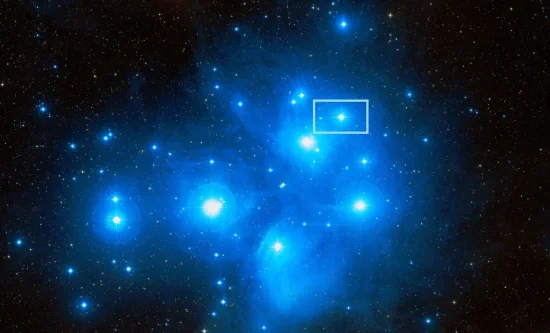
Taygeta (19 Tauri Aa), image: Wikisky
The binary companions are designated 19 Tauri Aa (formally named Taygeta) and 19 Tauri Ab. Even though the name officially applies only to the primary companion, it has been traditionally used for the entire star system. In addition to the Flamsteed designation 19 Tauri, the system also has the Bayer designation q Tauri, but the latter is not commonly used.
The binary system has a visual companion, an 8th magnitude star designated 19 Tauri B, separated by 69 arcseconds from the main pair. The star is not believed to be physically related to the 19 Tauri A system and lies further away. It is believed to be a yellow star a bit larger and more massive than the Sun.
Pleiades
Taygeta is the sixth brightest star in the Pleiades cluster. The brightest members are young, hot blue stars that formed in the last 100 million years. They are located at an average distance of 444 light years from the Sun. The cluster contains over 1,000 confirmed members and many more unresolved and faint stars. The total mass of the cluster is about 800 solar masses.
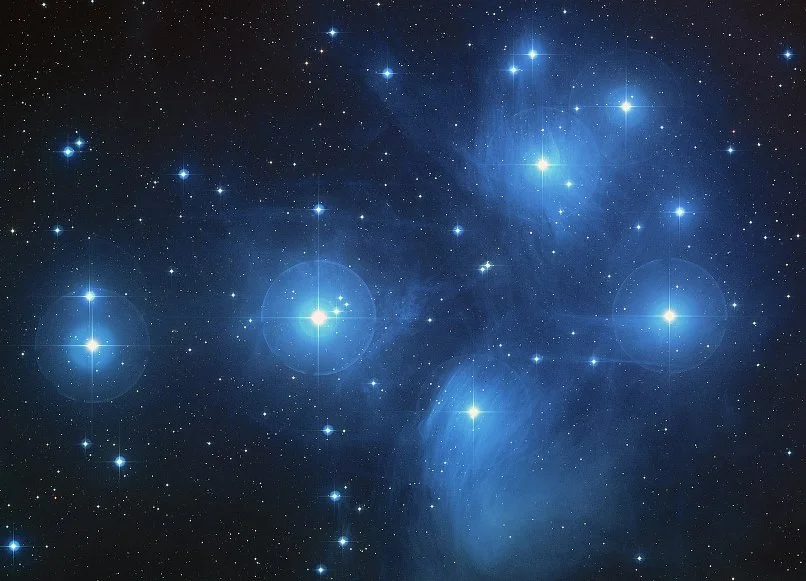
The Pleiades (M45), image: NASA, ESA, AURA/Caltech, Palomar Observatory, credit: D. Soderblom and E. Nelan (STScI), F. Benedict and B. Arthur (U. Texas), and B. Jones (Lick Obs.)
The French astronomer Charles Messier catalogued the Pleiades as the 45th object in his catalogue. The Messier catalogue is a compilation of deep sky objects that may be mistaken for comets, which makes the inclusion of the Pleiades and several other well-known objects, such as the Andromeda Galaxy and the Beehive Cluster, a bit curious. However, as the catalogue is one of the most popular lists of bright deep sky objects that can be observed in amateur telescopes, the cluster is commonly known as Messier 45 (M45).
M45 is very easy to observe because it is exceptionally bright and large, covering 110 arcminutes of the apparent sky. The cluster has a visual magnitude of 1.6 and is easily visible to the unaided eye. In ideal conditions, it is possible to make out up to 14 stars in the cluster, but observers normally see six to eight members.
The Pleiades stars formed in the same molecular cloud at about the same time and have been travelling together ever since. They will keep moving through space together for another 250 million years before the cluster gradually dissipates.
The nine brightest stars in M45 are named after the Pleiades, the Seven Sisters in Greek mythology – Alcyone (Eta Tauri), Asterope (21 Tauri), Celaeno (16 Tauri), Electra (17 Tauri), Maia (20 Tauri), Merope (23 Tauri) and Taygeta (19 Tauri) – and their parents Atlas (27 Tauri) and Pleione (28 Tauri).
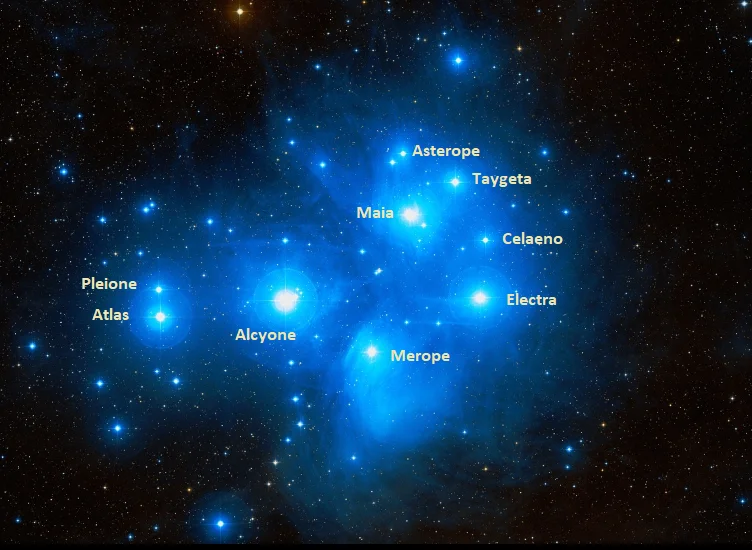
The Pleiades, image: Wikisky
The mythical Pleiades were pursued by Orion, a giant huntsman who saw his opportunity after Atlas was condemned to carry the heavens on his shoulders. Zeus stepped in to protect the sisters and turned them first into doves and then into stars to comfort their father. Orion constellation still appears to be pursuing the sisters across the sky.
Facts
The Pleiades have been known to cultures across the globe since at least the Bronze Age. The oldest depiction of the cluster was found on the Nebra sky disk, a Bronze Age artifact dating back to around 1600 BCE. The cluster was also mentioned in a number of ancient texts, including the Bible, Homer’s Iliad and Odyssey, and Hesiod’s Works and Days.
The Italian astronomer, physicist and engineer Galileo Galilei was the first to see the cluster in a telescope. He discovered that it contained many more stars than those visible to the unaided eye. Galilei published his notes and a sketch of the Pleiades in March 1610. The sketch depicted 36 stars.
The French astronomer Edme-Sébastien Jeaurat published a map of 64 cluster members in 1786.
The Pleiades cluster was mentioned as Mutsuraboshi, meaning “six stars,” in the 8th century Kojiki (“An Account of Ancient Matters”), an early compilation of Japanese myths, legends and oral histories. Today, the Japanese know the Pleiades as Subaru. The car company of the same name uses an image of the cluster’s six brightest stars in its logo.
Name
The name Taygeta (pronunciation: /teɪˈɪdʒɪtə/) comes from Greek mythology. The star was named after one of the Pleiades, the seven daughters of the sea nymph Pleione and the Titan Atlas. In mythology, Taygete (Greek: Ταϋγέτη) and her sisters were companions of Artemis, the goddess of the hunt. Taygete was pursued by Zeus and she turned to Artemis for protection. The goddess turned her into a doe with golden horns. According to some sources, Taygete was the mother of Eurotas, king of Laconia, and of Lacedaemon, the founder of Sparta, by Zeus. In Greek lore, Eurotas left his kingdom to Lacedaemon, who renamed it after his wife, Sparta.
The name Taygeta was officially approved by the International Astronomical Union’s (IAU) Working Group on Star Names (WGSN) on August 21, 2016. It formally applies only to the component 19 Tauri Aa.
The Chinese know Taygeta as the Second Star of Hairy Head. Hairy Head is an asterism formed by the Pleiades stars Asterope, Atlas, Electra, Maia, Merope, Taygeta, and Alcyone. It is one of the seven mansions of the White Tiger.
Location
Taygeta and other Pleiades are very easy to find because they belong to one of the most conspicuous open star clusters in the sky. The Pleiades cluster is easily spotted on its own because it appears as a bright bunch of grapes near Orion, but it can also be located using the three stars of Orion’s Belt, Alnitak, Alnilam and Mintaka. The cluster lies on the imaginary line extended from the Belt stars past the bright Aldebaran.
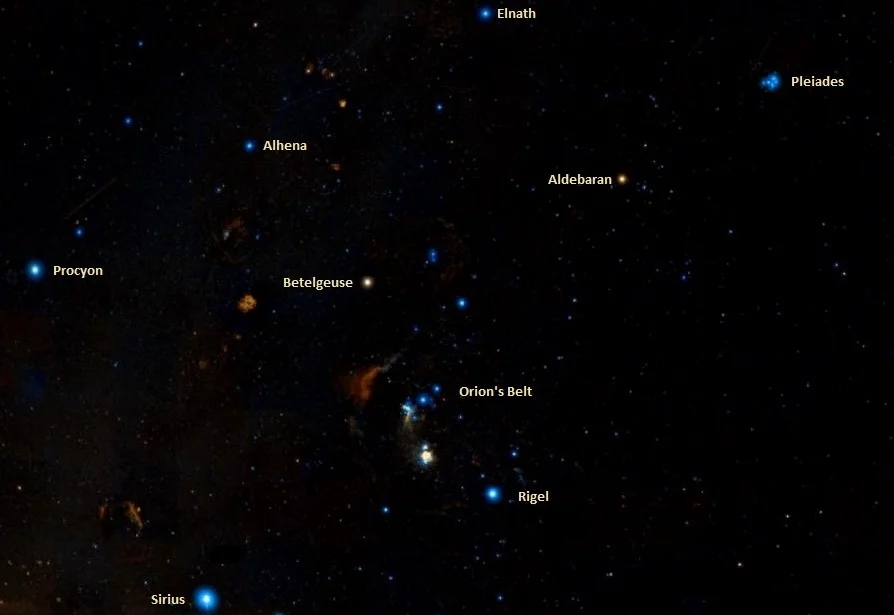
Pleiades location, image: Wikisky
The Pleiades can be observed from October to April, when the cluster is high above the horizon. In May and June, it stays too close to the Sun and is invisible to observers at night.
Constellation
Taygeta is located in the constellation Taurus. Occupying an area of 797 square degrees, Taurus is one of the largest northern constellations, as well as one of the oldest. It is one of the Greek constellations, first listed by the Greco-Roman astronomer Ptolemy in his Almagest in the 2nd century CE, but it has been known to observers well before Ptolemy’s time.
Taurus is best known for its bright stars Aldebaran, the 14th brightest star in the sky, and Elnath, once considered to be part of the constellation Auriga, and for its two exceptionally bright open clusters, the Pleiades and the Hyades. The Pleiades mark the shoulder of the celestial Bull, while the Hyades outline its V-shaped head. Aldebaran, the Bull’s eye, appears as the brightest member of the Hyades even though it is much closer to us and not physically related to the cluster.
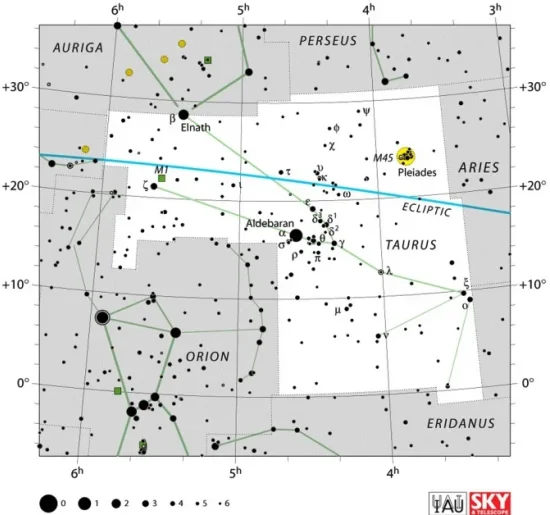
Taurus constellation map by IAU and Sky&Telescope magazine
Taurus contains several other famous deep sky objects. These include the historic supernova remnant known as the Crab Nebula, the first entry in Charles Messier’s catalogue (Messier 1), the reflection nebula NGC 1555, also known as Hind’s Variable Nebula because it varies in brightness due to being illuminated by the variable star T Tauri, and the planetary nebula NGC 1514, nicknamed the Crystal Ball Nebula due to its peculiar appearance. Other notable deep sky objects in Taurus include the relatively bright open clusters NGC 1647 and NGC 1817, the supernova remnant Sh2-240 (the Spaghetti Nebula), and the interacting galaxies NGC 1409 and NGC 1410.
The best time of year to observe the stars and deep sky objects in the constellation is during the month of January.
The 10 brightest stars in Taurus are Aldebaran (Alpha Tau, mag. 0.86), Elnath (Beta Tau, mag. 1.65), Alcyone (Eta Tau, mag. 2.87), Tianguan (Zeta Tau, mag. 2.97), Chamukuy (Theta2 Tauri, mag. 3.40), Lambda Tauri (mag. 3.47), Ain (Epsilon Tau, mag. 3.53), Omicron Tauri (mag. 3.61), Atlas (27 Tau, mag. 3.63), and Prima Hyadum (Gamma Tau, mag. 3.654).
Taygeta – 19 Tauri
| Spectral class | B6IV |
| U-B colour index | -0.48 |
| B-V colour index | -0.12 |
| Apparent magnitude | 4.30 |
| Distance | 440 light years (135 parsecs) |
| Parallax | 7.97 ± 0.33 mas |
| Radial velocity | 10.1 km/s |
| Proper motion | RA: 21.24 ± 0.38 mas/yr |
| Dec.: 40.56 ± 0.35 mas/yr | |
| Mass (19 Tau Aa, 19 Tau Ab) | 4.5 M☉, 3.2 M☉ |
| Luminosity (19 Tau Aa, 19 Tau Ab) | 600 L☉, 150 L☉ |
| Temperature | 13,400 K |
| Constellation | Taurus |
| Right ascension | 03h 45m 12.49578s |
| Declination | +24° 28′ 02.2097″ |
| Designations | Taygeta, 19 Tauri, q Tauri, HD 23338, HR 1145, HIP 17531, GC 4486, GCRV 2086, SAO 76140, BDS 1848, BD+24°547, CCDM 03452+2429, IRAS 03421+2418, 2MASS J03451250+2428021, PPM 92818, WDS J03452+2428A, TYC 1803-1585-1, Gaia DR2 65296907494549120 |